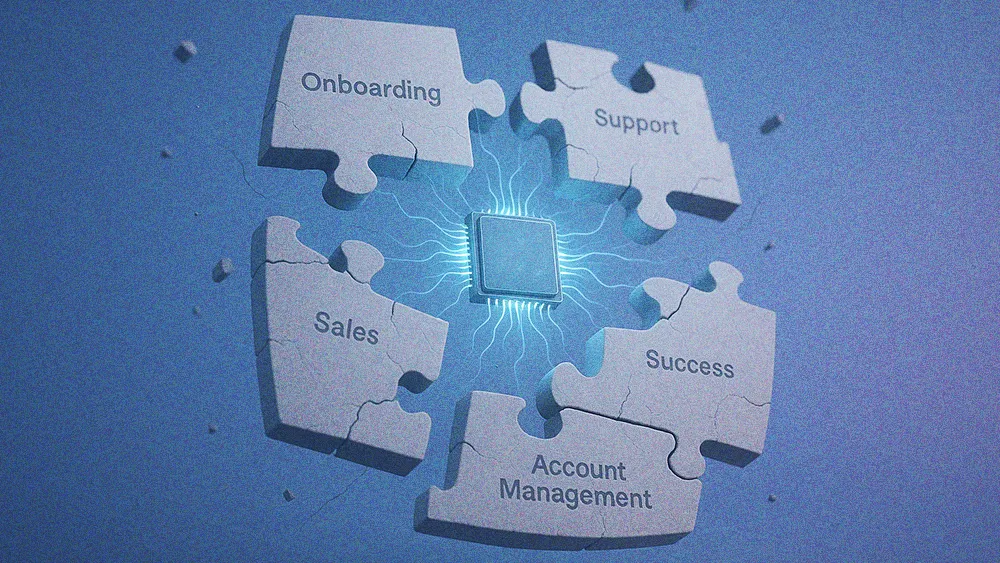Enterprise
The Great De-Siloing: Why an Oracle Vet Says Customer Success Must Collapse to Survive AI
Friday August 8, 2025

The inefficiency of separate customer support and success functions is prompting a shift to product-led models.
Manil Vasantha envisions a future without post-sales teams, where products are self-sufficient and intuitive.
Rushing into AI adoption without understanding it can lead to ineffective systems and workforce downsizing.
Vasantha advocates for a "human-in-the-middle" approach for effective data management.
His successful automation of Oracle's support cases highlights the potential of AI in streamlining operations.
Everybody better stop their new incubation of SaaS products and start thinking in a more modular fashion. It may set you back, but it's better to be set back initially than to push a product out and suffer through the next 10 years.

Manil Vasantha
CX Consultant,
The traditional silos of customer support and customer success are cracking under the weight of their own inefficiency. For decades, these functions have operated in separate, often misaligned, orbits. But as AI accelerates a move toward leaner, product-led business models, that fractured structure is no longer just inefficient; it’s a liability. A radical restructuring is coming, one that collapses post-sales functions entirely and redefines the very nature of a customer relationship.
We spoke with Manil Vasantha, a veteran leader in customer experience who has tackled large-scale automation challenges, including for Oracle’s Fusion Apps. While most leaders are caught in a panicked “AI Gold Rush,” Vasantha is focused on the foundational blueprint required for survival: a world with no support tickets, no dedicated success teams, and a product so intuitive it supports itself.
A function built on sand: “Customer success is more soft touch,” Vasantha says, laying out the core of the problem. “Historically, customer success has never been documented. When I do phone calls, audio calls, video calls, these go unaccounted for.” This lack of quantifiable data means the function is often misunderstood, measured by simplistic renewal metrics, and staffed by junior members who get lost in a “rabbit hole” of low-level support tasks, leading to internal “blame games.”
No more post-sales: In Vasantha’s vision, the entire concept of a post-sales organization is eliminated. The future belongs to small, agile teams running on a PLG engine. “That's how you generate a billion-dollar company from your garage that large company CEOs are afraid of,” he says. In this model, the product sells itself, and a lean “customer relationship team” reports directly into product management. The ultimate goal is a product so self-sufficient it requires no visible help desk.
He advises companies to stop building on outdated SaaS architecture. "Everybody better stop their new incubation of SaaS products and start thinking in a more modular fashion," says Vasantha. “It may set you back,” he warns, “but it's better to be set back initially than to push a product out and suffer through the next 10 years.”
Companies are going to go through this inflection point where they will suffer through this consequence of downsizing their team saying, ‘oh, we have an effective AI system’—which will not work.

Manil Vasantha
CX Consultant,
Unleashing the beast: Vasantha warns that the industry’s fear-driven rush into AI will backfire spectacularly. The problem, he says, is uninformed leaders chasing a silver bullet. “They're jumping because they don't know the beast,” he explains. “They say, ‘Yes, we need to have this AI agentic workflow, hire this person, roll it out. I don't know how it works, but it's supposed to work.’”
This leads to his starkest prediction. “Companies are going to go through this inflection point where they will suffer through this consequence of downsizing their team saying, ‘Oh, we have an effective AI system’—which will not work.” His warning echoes the recent controversy surrounding fintech company Klarna, which faced backlash over reports of replacing human roles with an AI assistant.
RAGs to riches: How can every bit of data a company generates be reused and repurposed for a strategic outcome? “If you're a brand new startup, you need to start building up on the database,” Vasantha states. It’s about implementing his “human-in-the-middle" process, where human experts vet every customer interaction before it’s added to a RAG database. “We are not trying to automate humans, we are trying to make them more efficient,” he clarifies. “Customer success is removed from all the noise and they can concentrate on nothing but renewals. They can take on more accounts.”
Trust in this system is a “sliding bar.” A company can only cede control as its data becomes richer, enabling an evolution from reactive “context-sensitive help” to a proactive “self-heal methodology.”
Sorted and supported: Vasantha points to his work automating Oracle’s Fusion Apps, which saw 16,000 support cases a month—a volume no one had automated successfully. His approach hinged on a simple three-bucket framework: “It's a known issue, known documentation, or a bug.” That structure created the clean, trustworthy data needed to build an AI engine that picked the best of three validated answers, all vetted through the human-in-the-middle process.
It’s the same blueprint he believes can pull companies back from the AI hype cliff and toward a more resilient, product-led future. “I'm fighting the new battle now,” he says.